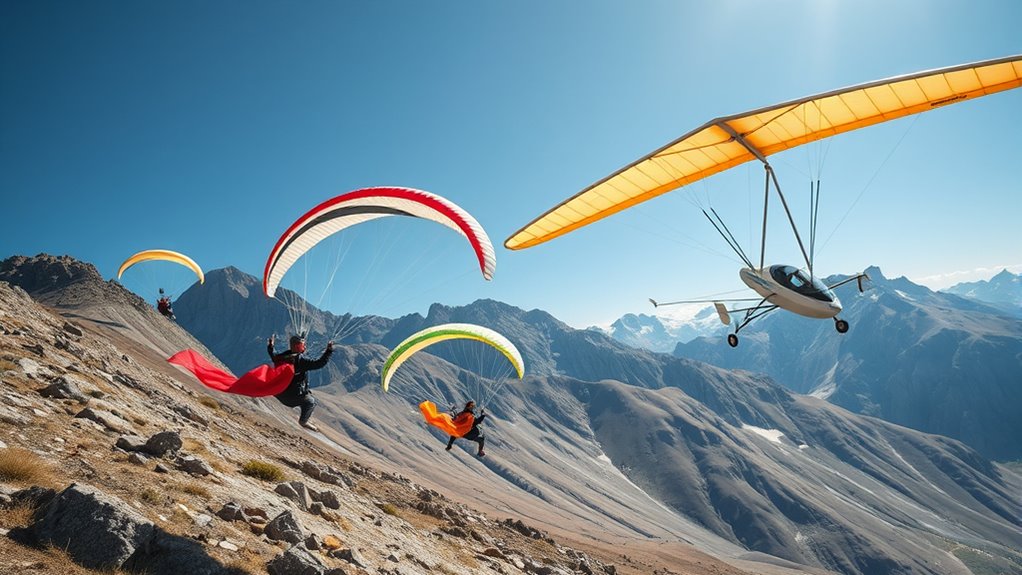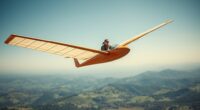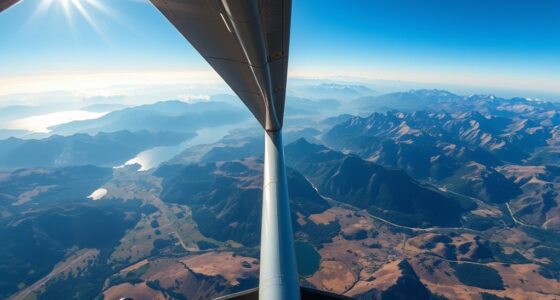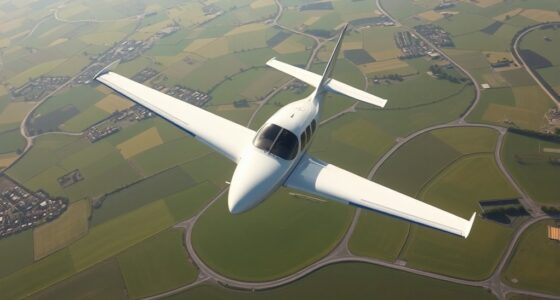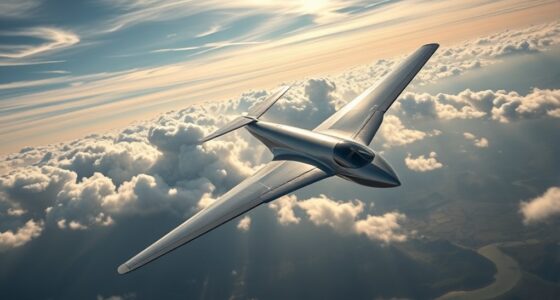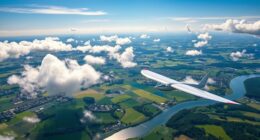When slope soaring with paragliders, you rely on running downhill to launch and use the wing’sflexibility to adapt to air currents, making takeoff easier and more forgiving. Hang gliders, however, require a longer, steeper slope for a more forceful launch by holding onto a control bar and running before lift-off. Their rigid wings provide stability but demand precise control. To discover the detailed differences and improve your technique, explore further insights below.
Key Takeaways
- Paragliders are launched by running downhill and rely on aerodynamic flexibility for lift, while hang gliders need a steeper slope and a more forceful run.
- Paragliders use gentle, controlled runs with adaptable wings, whereas hang gliders require precise control and higher physical effort during takeoff.
- Slope soaring with paragliders involves managing a semi-rigid wing that responds to airflow, contrasting with hang gliders’ rigid wing for stable lift.
- Paraglider techniques emphasize soft, gradual acceleration, while hang glider techniques focus on maintaining optimal speed and angle of attack for stability.
- Control during slope soaring differs: paragliders adjust canopy shape easily, whereas hang gliders rely on fixed wing stability and precise pilot inputs.

While both paragliders and hang gliders allow you to soar through the air, they differ considerably in design and flight experience. One of the most noticeable differences is their wing shape. Paragliders have a flexible, canopy-like wing made from lightweight fabric that forms a semi-rigid airfoil. This wing is designed to be highly adaptable, with its shape maintained by the aerodynamic forces during flight. In contrast, hang gliders feature a rigid wing structure, often made from aluminum tubing covered with a durable fabric. The wing’s shape is fixed, providing a more stable, predictable airflow, which influences how you control the glider.
Paragliders have flexible wings, while hang gliders feature rigid, fixed structures for stability and control.
When it comes to launch methods, the differences are equally significant. Paragliders are typically launched by running downhill, harnessing gravity to generate enough lift for takeoff. You can also use assistance devices like winches or tow systems, but most pilots prefer a simple foot launch on gentle slopes or even flat ground with proper wind conditions. The launch process for paragliders is relatively gentle and straightforward, requiring minimal equipment aside from the glider, harness, and sometimes a small tow. On the other hand, hang gliders demand a more robust launch approach. You usually need a longer, steeper slope to generate enough airspeed for takeoff. The pilot runs with the glider, holding onto a control bar, until enough lift is generated to become airborne. This process demands more physical effort and precise timing, especially because the rigid wing’s shape requires careful handling during launch to maintain stability.
Because of their wing shapes, paragliders are more forgiving during launches, offering a softer, more controlled takeoff experience. Their flexible canopy adjusts to airflow, making it easier for beginners to manage the transition from ground to air. Hang gliders, with their rigid wings, require a more forceful run and precise control during launch to prevent instability. The fixed wing shape means you need to be more attentive to your speed and angle of attack to ensure a smooth lift-off. Additionally, advancements in wing technology have enhanced the safety and performance of both types, influencing pilot preferences and capabilities.
In essence, your choice between paragliding and hang gliding for slope soaring depends largely on your comfort with different launch styles and how you prefer your wing to behave in the air. Paragliders provide a more effortless launch experience with greater adaptability, while hang gliders demand a bit more physical effort and skill during takeoff but offer a different, often more stable, flying sensation.
Frequently Asked Questions
How Does Wing Design Affect Slope Soaring Performance?
Your wing design directly impacts slope soaring performance through wing stability and glide ratio. A more stable wing helps you maintain control in turbulent air, making it easier to stay on the slope. Additionally, a higher glide ratio allows you to cover more distance with less altitude loss, enhancing your overall efficiency. Fewer adjustments are needed, so your focus stays on finding lift and enjoying the glide.
What Are the Key Safety Considerations for Each Glider Type?
You should prioritize launch site safety by checking for obstacles and weather conditions before flying. Always review emergency protocols for both paragliders and hang gliders, such as quick descent techniques and emergency landing procedures. Wear proper gear, stay aware of your surroundings, and communicate with others on site. Regularly assess your skills and equipment to minimize risks, ensuring a safe and enjoyable slope soaring experience for both glider types.
Can Beginners Easily Switch Between Paragliding and Hang Gliding?
Jumping from paragliding to hang gliding isn’t a walk in the park, but it’s doable with some cross training benefits. You’ll find that core skills like control and wind awareness transfer well, making the switch smoother. However, each craft has unique techniques, so beginners should expect a learning curve. With practice, you can develop skill transferability, but don’t expect to master both overnight — patience is key.
How Do Weather Conditions Differently Impact Paragliders and Hang Gliders?
Weather conditions impact paragliders and hang gliders differently. You’ll notice thermal dynamics play a bigger role for paragliders, as rising warm air helps you gain altitude. Hang gliders, on the other hand, are more affected by wind shear, which can cause sudden shifts in wind speed and direction. You need to adapt your control techniques accordingly, constantly monitoring weather patterns to make certain of safe and efficient flights.
What Equipment Differences Are Essential for Slope Soaring?
For slope soaring, you need specific gear essentials like a sturdy harness, a reliable variometer, and appropriate wing accessories. Your slope soaring gear also includes a helmet, gloves, and suitable clothing for weather changes. Make certain your equipment is lightweight and durable, designed for quick setup and easy handling. These essentials ensure safety, control, and efficiency as you harness wind currents and master your altitude and glide.
Conclusion
Ultimately, both paragliders and hang gliders rely on slope soaring, but their techniques differ due to design. Paragliders, with their flexible wings, require subtle weight shifts and precise control, while hang gliders, with rigid frames, demand more body positioning. Notably, some experts believe that the theory of wing flexibility influencing maneuverability holds true here. By understanding these nuances, you can better appreciate how each craft harnesses the terrain’s lift, enhancing your soaring experience.
